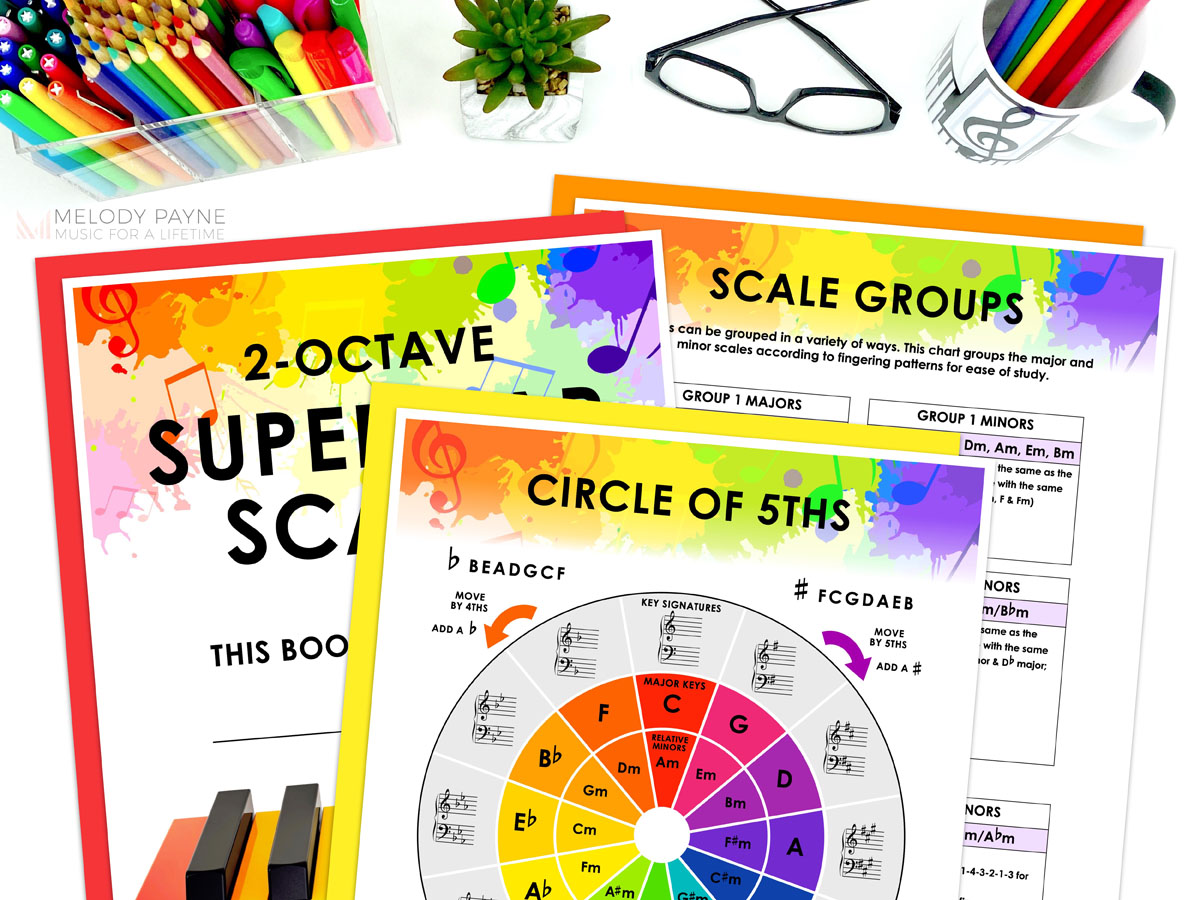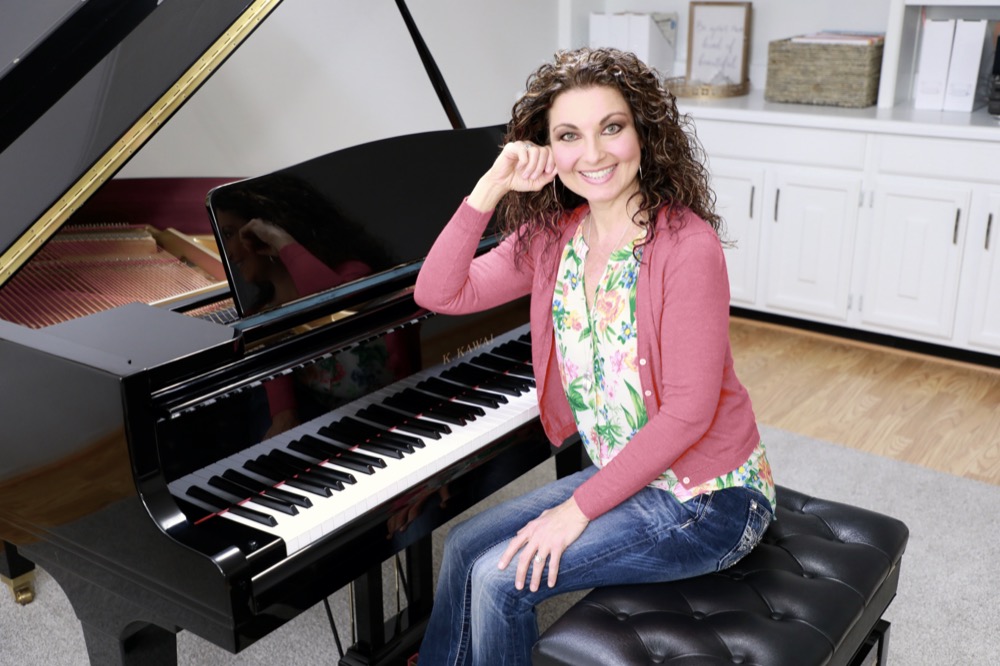13 Fail-Proof Ways to Teach 2 Octave Piano Scales and Chords
This post may contain affiliate links. If you purchase something through an affiliate link, I will receive a small commission at no cost to you. For more information, read the disclosure statement here.

I’m excited to write about the newest release in the Superstar Scales Piano Technique Book series and share the perfect way to teach 2 octave piano scales and chords and arpeggios!
Sometimes, the quest for the “perfect system”–whether it’s the search for the perfect technique book or the perfect system to teach scales–can leave some teachers feeling like they don’t have it all figured out.
Teachers should feel empowered to thoughtfully try out different approaches within their teaching practices until they find what works best for them and their students.
Teachers can feel confident in experimenting with different teaching strategies when using high quality educational resources such as the Superstar Scales Technique Book series.
In this post I’ll be sharing fail-proof ways to teach 2 octave piano scales and chords using the Superstar Scales Piano Technique Book 4.

When to Introduce 2 Octave Piano Scales and Chords
There are differing ideas out there when it comes to when or how to introduce scales.
I once had a piano teacher who said: “Better to learn the scales you need when you need them”.
I do think it makes sense to hold off on teaching scales such as B, F#, C#, B-flat, E-flat, and A-flat for students who are still quite a ways away from learning pieces in those keys.
I recommend looking to the method book series you are using as a clue for when to introduce scales.
Once the lesson book has the student learn the C Major scale, that’s probably a suitable time to get started with the easier scales of C, G, D, A, E, and F.
These scales will be the most useful for beginner through early intermediate students.
But is it okay to start 2 Octave Piano Scales and Chords and Arpeggios with beginners?
I’ve successfully experimented with jumping straight into Superstar Scales Piano Technique Book 4 – skipping one octave scales altogether – with students who are 8 years old and up by the time they are encountering scales in their lesson books.
It might take longer for a student to learn all their 2 octave piano scales initially, but once students cross this hurdle it is so much easier to transition to 3 and 4-octave scales. Try and see what works best for each of your students!
Older beginner students or students who practice minimally might be better off getting straight to the point with the 2 octave piano scales from Superstar Scales Piano Technique Book 4.
They can learn the 2 octave piano scales and chords that pertain to the repertoire they are learning, or will be learning soon.
However, if you don’t think your student is ready for 2 octave piano scales and chords, you can look into these resources:
- Teaching Beginning Piano Technique To Young Piano Students (for 5-finger pentascales with helper notes and accidentals)
- 5 Reasons To Use Junior Superstar Scales With Young Beginners (for 5-finger pentascales with key signatures, no helper notes)
- Teaching Scales, Chords, And Arpeggios Using The Superstar Scales Piano Technique Book (for 1-octave piano scales, chords, and arpeggios)

How to Introduce 2 Octave Scales Using Superstar Scales Piano Technique Book 4
1. Give an explanation…
After all, it’s a lot of work for students to learn the 2 octave piano scales and chords and arpeggios in Superstar Scales Piano Technique Book 4!
Students appreciate knowing why they need to do something. I give a brief explanation on why it’s useful and beneficial for them to learn scales.
2. …and/or just show them!
Play a section of a sonata/sonatina with just the barebones melody and harmony the first time through. Then play it again as written and see what they think.
They’ll probably say that the first time sounded fragmented, while the second time sounded much better. See if they can explain what made it sound better to them.
3. Use helpful analogies.
You might try using the analogy of a bridge.
“These scalar passages with the neighboring tones connect the musical ideas together. Scales are hidden throughout pieces, so it’s especially useful to know them. Once you learn the scales, your fingers will automatically know what to do!”
4. Show them the colorful Superstar Scales Piano Technique Book
With the 2 Octave Piano Scales and Chords book at hand, show them exactly what they’re getting into.
- Show them how they can fill in the stars when they learn the RH and LH.
- Explain that students can collect/earn more rainbow scale pages for their piano binder through learning their assigned scale. (Rather than print out the entire book for students, I print out pages as needed.)
- Write in the finger numbers and note names at the top for the first scale they will be learning.
5. Teach the first scale from Superstar Scales Piano Technique Book 4
When you’re ready to start your student on 2 octave piano scales and chords, spend the first few minutes of the lesson on technique. I try not to spend more than 5 minutes on scales.
We focus on learning a new scale (if they have mastered the previous one), and I choose a random scale for review.
Students are expected to review learned scales, and those are listed on the assignment sheet.
Here’s some tips for teaching 2 octave piano scales:
- Demonstrate the scale.
- Teach the tricky part first: the cross-under after fingers 3 and 4.
- Don’t be too ambitious! It might be enough to learn the ascending scale this first week. Let students choose whether they are ready to try it backwards.
- As students practice the scale, they should be looking down at their hand while the teacher helps by calling out which finger number they should be on.
6. Host scale weeks in your studio.
You can work on the same scale with every student in your studio, for example, during C Major Week work on the C Major page in whatever Superstar Scales book they are using.
You can set a specific tempo goal for the week, or a listening goal (are the scales played with perfect vertical precision?), or a musical goal (did they play musically with variations in dynamics?)
If applicable, show them that we will be using the chords and chord progressions to learn how to play from lead sheets, which totally hooks them in.

7 Tips for Making 2 Octave Piano Scales and Chords and Arpeggios More Interesting and Fun
1. Use Progress Charts with Superstar Scales Piano Technique Book 4
Get students excited about seeing their own progress on a Studio Scale Tracker Poster. This can be printed 8.5 inches by 11 inches at home, and if you’d like a larger poster size (17 inches x 22 inches), easy instructions are included for printing this size at home using multiple sheets of card stock.
I like keeping an individual scale progress chart in a student’s piano binder so we can easily see what comes next.
It is so motivating for students to chart their own progress!
2. Use a Backing Track with Superstar Scales Piano Technique Books
Add a touch of excitement by encouraging your students to practice their 2 octave piano scales and chords with external aids such as…
- Super Metronome
- MusiClock
- PianoScales.org free backing tracks (they also offer chord charts that can be used for improvising in different keys!)
3. Assign challenges using the Superstar Scales Piano Technique Books
Set a tempo goal for scales and arpeggios. You may find that students really enjoy playing scales much faster than they thought they could!
4. Use Pieces With Scales while learning 2 Octave Piano Scales and Chords
Piece ideas:
- Wunderkeys Rock Tuck and Roll!
- Seeing Stars by Jennifer Eklund. This piece is based entirely on C Major. I like the search function for ‘tonal center’ within the Piano Pronto website. This is a terrific way to find fun pieces for students in specific keys.
5. Use Different Rhythms, Groupings, and Touches while studying 2 octave Piano Scales and Chords
Unusual ways to practice scales:
- Different rhythms
- Swing, long-short, short-long
- Different dynamics in each hand
- Different articulation in each hand
- Parallel, opposite
- How would a _____ play this scale? Kitten, elephant, sleepy student, excited monkey, etc.
6. Technique Trading Cards to use with Superstar Scales Piano Technique Books
Every time a student begins a new technical exercise, give them one of these technique trading cards to slide into a business card holder sheet in their binder. Once they’ve mastered it, they get a sticker on their card!
It can be a fun challenge to see how many cards students can collect in a year.
7. Supplement with Tried-and-True Technique Books that Teachers Like
- Accelerando Series (Books 4-6)
- Technique for the Advancing Pianist (Published by Alfred)
- Dozen a Day (Young Beginners)
- Boris Berlin’s Essential Daily Exercises
- Czerny Selected Piano Studies – Volume 1
- Pathways to Artistry by Catherin Rollin
- Exploring Piano Classics Technique by Nancy Bachus

Introducing 2 Octave Piano Scales and Chords and Arpeggios in the Superstar Scales Piano Technique Books
There is no set way to use the Superstar Scales Piano Technique Books!
You can choose to teach just the major and minor scales first, and introduce the arpeggios and chords later.
Or, you can teach the 2 octave scales, chords, and arpeggios all at the same time. It depends on the student.
For young beginning students with smaller hands, it may make sense to delay the introduction of chords until they are playing chords in their pieces.
Using the Superstar Scales Piano Technique Book 4 to Prep for Music Exams
The Superstar Scales Technique Book 4 includes all the 2-octave major and minor scales, arpeggios, as well as two versions of chord progressions in all major and minor keys.
Check out the 2 Octave Superstar Scales video to see if the Superstar Scales Technique Book 4 includes everything you are looking for based on the exam requirements.
If you are new to exams and interested in RCM, Joy Morin has a blog post and free printable for the 2022 Technical Requirements that you may find useful here.
The Superstar Scales Technique Book 4 is the perfect resource for teaching 2 octave piano scales and arpeggios! Book 4 can be used for beginners, but it is a particularly useful resource for late beginners and beyond, since they need to learn how to recognize the notes within scale passages in their scores.
This technique book gives students opportunities to practice seeing those high and low ledger line notes before they encounter them in their pieces.
Grab Superstar Scales Technique Book 4 here today and watch your students’ technical abilities soar!

Even more blog posts to help spice up your teaching…
- Save Time With Over 200 Print-and-Go Music Theory Worksheets!
- Introducing the Circle of Fifths to Your Music Students
- 5 Reasons to Include Collaboration in Your Piano Studio
Don't miss out!
Follow on Facebook and Instagram, join the best Facebook group for piano teachers, and subscribe to the newsletter to get helpful teaching tips, resources, and tutorials delivered straight to your inbox every week.
Michelle Madasamy
Michelle Madasamy
Welcome!

Hi! I’m Melody Payne, a pianist and piano teacher, educational resource author, a fun-loving wife to the most wonderful and talented hubby I could ask for, and a lifelong learner who loves to share. I want to make your life as a music teacher easier by writing and sharing helpful and relevant music teaching articles, and by creating educational resources with your very own students in mind. If you are a parent who wants to enroll your child in piano lessons, I’d love for us to get started building those skills that can give your child a lifetime of musical enjoyment!

